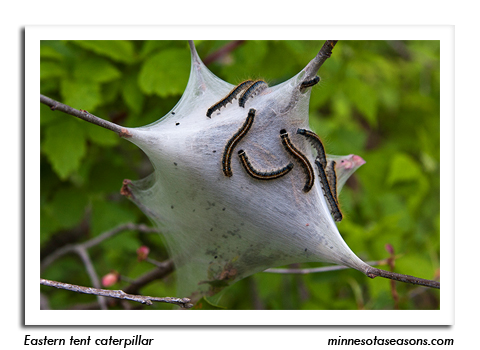
 |
|
|
Looking Ahead
Volume 60 Number 1 Date 04/23/2015 BLACK CUTWORM - Moth collections have not increased substantially since the first migrants arrived in the state on April 1. Counts ranged from 0-8 moths per trap for the monitoring period of April 16-22 and from 0-2 per trap the week before. No significant flights into Wisconsin have been documented as of April 22. BROWN MARMORATED STINK BUG - Six specimens have been found so far in 2015: three from the Madison area of Dane County and three in Milwaukee County. The identifications were confirmed by PJ Liesch of the UW-Madison Insect Diagnostic Lab. The number of new cases this year compares to seven confirmed BMSB reports in 2013 and 2014 combined, and suggests this invasive is established in the state. Reproducing populations are suspected in Dane County, though BMSB still has not been trapped or observed in any agricultural setting in Wisconsin. EASTERN TENT CATERPILLAR - Overwintered eggs began hatching by April 1 in Rock County following the accumulation of 50 degree days (base 50°F). The first tents are becoming apparent on wild cherry, apple, flowering crabapple and other host trees. Control is advised while the larvae and tents are still small. ALFALFA WEEVIL - One adult weevil was collected in Grant County on April 17, signaling the start of spring egg deposition in alfalfa stems. Larval emergence remains another two weeks away. LILY LEAF BEETLE - An April 19 report from Marathon County confirms the winter survival of lily leaf beetle (LLB), a destructive introduced pest of cultivated lilies detected for the first time in Wisconsin last June. Several overwintered beetles were observed on lily foliage at a residence in Mosinee. Gardeners and homeowners in Marathon County are asked to remain alert for LLB this season and take measures to prevent it from spreading. Lily leaf beetle sightings should be reported to the DATCP Nursery Program at datcpnursery@wisconsin.gov. TRUE ARMYWORM - The first indication of armyworm arrival was during the week of April 8-14 at Janesville in Rock County. Minimal activity has been reported since then, with only 15 adults appearing in black light and pheromone traps. Similar to the black cutworm, this long-range migrant overwinters in the south-central U.S. and arrives in Wisconsin each spring on southerly storm fronts. Outbreaks are sporadic and usually develop during cool, wet years, especially following a drought. -- Krista Hamilton, DATCP Entomologist 




|
|
|